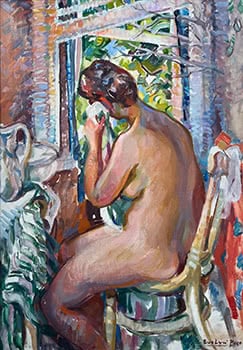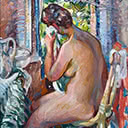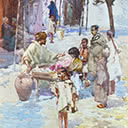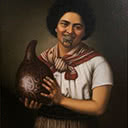Young Woman in a Bay Window
75 x 51.2 cm
PROVENANCE John Leech Gallery Private Collection, Auckland
Famed for her uniquely lush and sensuous renditions of the female nude, Wellington painter Evelyn Page (née Polson) was born the youngest child of seven into a wealthy Christchurch family in 1899. Aged just 16 she enrolled at the School of Art Canterbury College, winning a medal for her skill in painting and completing her Diploma of Fine Arts in 1921. Always interested in the French Post-Impressionists, she was instrumental in founding The Group in 1927, an exhibiting society comprised mostly of younger painters who were interested in modernism. She taught for six years at the School of Art from 1930, becoming a foundation member of the New Zealand Society of Artists in 1933, which aimed 'to interest the public in the living movements in art'.
Her soon-to-be husband Freddie Page won a scholarship to study at the Guildhall in London, and she accompanied him, spending time studying paintings in the Tate, National Gallery and Royal Academy before going on a camping tour of Europe in the summer. She began to paint in high-keyed colours, allowing the white primed canvas to shine through her brushstrokes. Returning to Canterbury, the couple married and set up house in the 1851 Dyer family homestead "Waitahuna" at Governor's Bay on Bank's Peninsula which they rented for seven years. Here she refined her techniques for portrait painting, depicting many of the talented artists, architects, writers and musicians who were part of the couple's circle.
After the war, Fred Page was appointed to the School of Music at Victoria University in 1946, and by 1948 the family were living in a double-storeyed Edwardian villa at 20 Hobson Street, Thorndon, the setting for this painting. She loved to paint figures seated at the distinctive upper storey oriel window with characteristic double-hung sliding sashes, often nudes like this one, at their toilette. Returning to Britain and Europe in 1950 she had sufficient work for a solo exhibition in Dunedin in 1952, and she was part of a New Zealand Cultural Mission to China in 1956. Throughout the 1960s she concentrated on the female nude, her favourite subject, and was awarded a QEII Arts Council grant to study at the Kokoschka School in Vienna.
Page's skill at enlivening a painting surface with dynamic brushwork is evident here in the treatment of the window surround, tablecloth and the towel that the model uses to dry her ear. The basin and ewer are props seen in many of Page's paintings, and follow the precedent set by Degas and other French painters for a baigneuse or bather scene. Colours ranging from blue, purple and green through to pink and orange can be seen in the treatment of the model's flesh, which is catching the dappled summer light filtered through the leaves of the magnolia tree outside. Capturing her subject from close range, Page re-creates the voluptuous, back-turned seated pose of Ingres famous Valpinçon bather from the Louvre and the bather playing the mandolin in The Turkish Bath, but rendered in her modern and dynamic style.
LINDA TYLER





